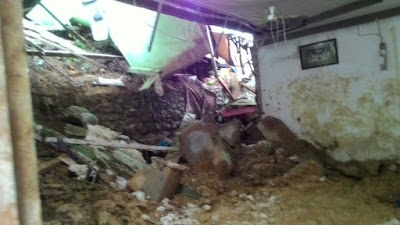Three people have died in flash flooding in the city of Sibolga in North Sumatra in flash flooding on Monday 26 March 2018. Heavy rains began in the city at about 3.00 pm local time and persisted until about 11.00 pm. In the Aek Muara Pinang area of the city Aura Kasih Simanjuntak, 2, was swept away by floodwaters and found dead later, while in the Kampung Baru Sikaje-kaje Aek Manis area Linda Citra, 35, and her daughter Flara Citra, 5, were killed when their house was hit by a landslide triggered by floodwaters undermining a cliff. A second child, Stefani Claudya, 9, was seriously injured in this incident, which is described as having caused severe damage to three houses. Landslides are a common problem after severe weather events, as excess
pore water pressure can overcome cohesion in soil and sediments,
allowing them to flow like liquids. Approximately 90% of all landslides
are caused by heavy rainfall. Flash floods are a particular problem in areas where urban sprawl has resulted in areas where the ground is covered by non-porous concrete of similar materials, preventing rainwater from sinking into the soil.
Damage caused by a landslip in the Kampung Baru Sikaje-kaje Aek Manis area of Sibolga, North Sumatra, on 26 March 2018. InfoPublik.
North Sumatra has a wet tropical climate, with a rainy season that lasts from October to April, when rainfall typically reaches 200-300 mm per month and a dry season from May to September, when rainfall is usually below 200 mm per month (though the area is never truly dry. This is driven by the Southeast Asian Monsoon Seasons, with the Northeast Monsoon driven
by winds from the South China Sea fuelling the wetter rainy season and the Southwest Monsoon driven by winds from the southern Indian Ocean the drier dry season. Such a double Monsoon Season is common
close
to the equator, where the Sun is highest overhead around the equinoxes
and lowest on the horizons around the solstices, making the solstices
the coolest part of the year and the equinoxes the hottest.
The winds that drive the Northeast and Southwest Monsoons in Southeast Asia. Mynewshub.
Monsoons are tropical sea breezes triggered by heating of the land during the warmer part of the year (summer). Both the land and sea are warmed by the Sun, but the land has a lower ability to absorb heat, radiating it back so that the air above landmasses becomes significantly warmer than that over the sea, causing the air above the land to rise and drawing in water from over the sea; since this has also been warmed it carries a high evaporated water content, and brings with it heavy rainfall. In the tropical dry season the situation is reversed, as the air over the land cools more rapidly with the seasons, leading to warmer air over the sea, and thus breezes moving from the shore to the sea (where air is rising more rapidly) and a drying of the climate.
Diagrammatic representation of wind and rainfall patterns in a tropical monsoon climate. Geosciences/University of Arizona.









